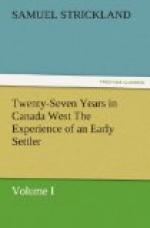Directly after the wheat is carted, the pigeons alight on the stubble in vast flocks. As they are chiefly the young broods, they are very easily approached: the sportsman should creep up behind them; for they are so intent on feeding, that they will seldom notice his approach till he is within fair range of them.
The hindmost ranks are continually rising from the ground, and dropping in front of the others. This is the proper time to fire, just as the hind-rank are a couple or three feet from the ground; firing the second barrel as the whole flock takes fight.
In the vicinity of the towns, sometimes a regular battue takes place, when all kind of firearms are in requisition, from the old Tower musket to the celebrated Joe Manton.
In July, the pigeons feed a great deal on wild berries, such as raspberries, huckle-berries, blue-berries, and a variety of other kinds. Many people would naturally think that such vast flocks of birds would alight on the standing grain, and destroy the crop: such, however, is not the case. Sometimes, during the seed-time in the spring, they are a little troublesome; but I have never known them alight on the ripening grain. The Canadian blackbirds are far more destructive in that particular—especially that species with the orange-bar across the wings. These birds alight on the Indian corn crops and oats in such numbers, that they do a great deal of damage, particularly the oats, which they break down by their weight.
There is another kind of blackbird, smaller than the former, and speckled very much like a starling. Indeed, I believe it is a species of that bird; for it frequents marshes, and lodges amongst the reeds at night. This bird is also destructive in the corn-fields.
There is yet a third species of blackbird, larger than either of the above, whose colour is of a glossy blue-black, very like our rooks. These birds are just as troublesome as the rest; but it must be admitted that their destroy an immense quantity of caterpillars and grubs. They are easily frightened away by firing a few shots. There is, however, no doubt but that they are a greater plague to the farmers than the pigeons: besides, the latter are excellent eating.
I once accompanied the Doctor on an exploring expedition through the tract. We encamped close to a breeding-place of these birds, when we were kept awake all night by the noise they made. Sometimes, too, a limb of a tree would break with the weight of the birds which had alighted on it, when there would be such fluttering and flapping of wings, as made it impossible for us to sleep.
Towards morning, the sound of their departure to their feeding-grounds resembled thunder. For nearly two hours there was one incessant roar, as flock after flock took its departure eastward. The ground under the trees was whitened with their excrement, and strewn with broken branches of trees.




